Sunflower early bloom, near Elgin, N.D., 2015.
(NDSU photo)
Fertilizing Sunflower (SF713, Revised Feb. 2016)
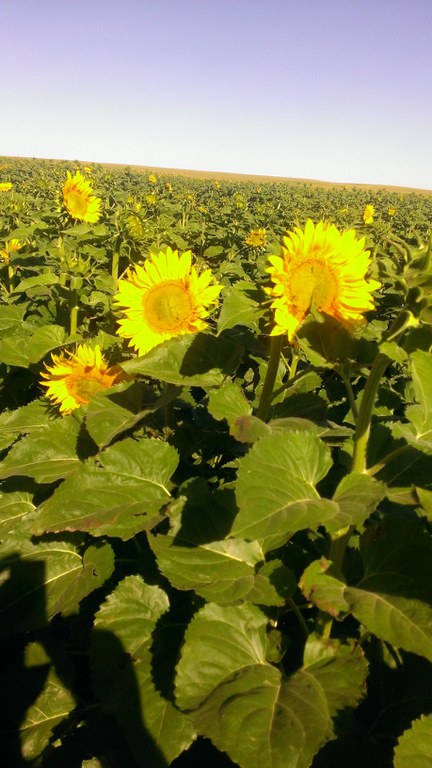
Perhaps due to the development of sunflower relatively recently in human history and its breeding as an oil seed mostly for yield, the efficiency of nitrogen (N) utilization by sunflower is relatively high. Nitrogen application increases plant height but may or may not increase yield.
Oilseed sunflower is grown, as the name indicates, for oil content. Increasing the N rate increases seed protein and decreases oil concentration (Darby et al., 2013). Confection sunflower is grown for human consumption as a snack food. It is dehulled and the kernel is used on salads, and in SunButter and bakery goods. It’s also incorporated into snack foods and other food recipes.
Currently, N recommendations for most states, including North Dakota, South Dakota, Nebraska and Kansas, are based on expected-yield formulas. Formulas include reducing N recommendations due to soil test nitrate (Nebraska, South Dakota, North Dakota, Kansas), organic matter (Kansas, Nebraska) and all states by manure and previous crop credits. In contrast to the implied N response formula, which most often is constructed as [(Yield Expected (pounds per acre) multiplied by 0.05) less credits], recent N rate experiments in other states have achieved less yield response to N than expected (Darby et al., 2013; Scheiner et al., 2002).
This revision of North Dakota sunflower N recommendations is based on the results from 52 total experiments: four North Dakota N rate experiments in 2012-13, 40 North Dakota N and phosphorus (P) rate experiments in 2014-15, and eight N and P rate experiments in South Dakota in 2014-15, with 48 total experiments taken to yield.
The results from these studies indicate that yield is independent of N rate, meaning that any formula of (Yield X (a factor) = N rate) is incorrect and nonpredictive. In addition, the new recommendations account for the greater susceptibility to lodging with higher N rates and the newly found relationship between higher N rates and increased sunflower disease. Although in the absence of high wind and disease, higher yield might be possible with higher N rates than those in the recommendation tables or in the future N calculator for sunflower, sunflower growers assume a greater lodging and disease risk if they decide to use higher rates.
Nitrogen
The new sunflower recommendations are regionally and tillage-based. Perhaps due to the deeper rooting nature of sunflower, soil texture had less effect on yield, compared with clay texture effect on corn N use efficiency in previous studies. However, at most sites, which were planted to sunflowers for the first time in more than 30 years or did not have a deep-rooted crop such as sugar beets or sunflowers within the past five years, yield response was very slight, if any increase occurred. Oil content tended to be near or below 40 percent, even with zero added N.
This would be possible only if these locations have some unaccounted for deep N. The western North Dakota site that was not planted to sunflower for at least five years experienced a major drought in 2012, followed by relatively wet seasons in 2013-2015, which may have moved N downward in the soil.
In the sunflower crop of 2015, the deeper N in this field likely was tapped, resulting in no yield increase with higher N rates and relatively low oil content in the seed. The sites in eastern North Dakota without sugar beet or sunflower in recent memory likewise did not have increased yield with higher N rates and had oil content that, even at the zero N rate, was below 40 percent.
If practical, new fields of sunflower should be sampled to at least a 4-foot depth to see if deeper N should be considered in N fertility recommendations. About 30 pounds of N from 2 to 4 feet in depth should be assumed but not subtracted from N recommendations. But if the 2- to 4-foot soil nitrate test is greater than 30 pounds N per acre, then the extra N should be subtracted from the total N recommendation.
If deeper soil sampling is not practical, an N nonlimiting area of a full rate of N based on the N calculator or the N recommendation tables should be applied, and about half the N calculator rate should be applied to the rest of the field. Using an active-optical sensor, Spad meter, or “best-guess” assessment of color differences and vigor of the N nonlimiting area, compared with the rest of the field, an N application could be made or not made from about stage V-8 to R1 (approximately V12 to V14) using a side-dress applicator or high-clearance applicator (Figure 1). In fields without sunflower, sugar beet or another deep-rooted crop such as safflower, no additional N likely needs to be applied.
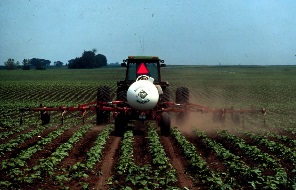
Figure 1. Side-dressing ammonia on sunflowers about V8.
Photo courtesy of Don Lilliboe.
Soil sampling to 2 feet in depth is very important for N recommendations in this region. Figure 2 displays all data from North Dakota in 2014 without consideration of soil test N. Note that yields from the zero N rate range from about 500 pounds per acre to more than 3,000 pounds per acre, so zero N would be a poor recommendation.

In contrast, Figure 3 shows the same yields with N rate and soil test nitrate-N to the 2 feet in depth considered for N fertility recommendations. The relationship is much improved, the shape of the response curve is similar to that of individual sites and the range at lower total N values is much narrower than when soil test N is not included.
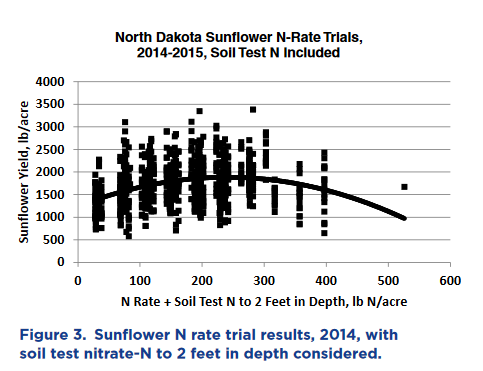
The N recommendations are based on differences in the response of sunflower in eastern North Dakota compared to those in western North Dakota (Figure 4).
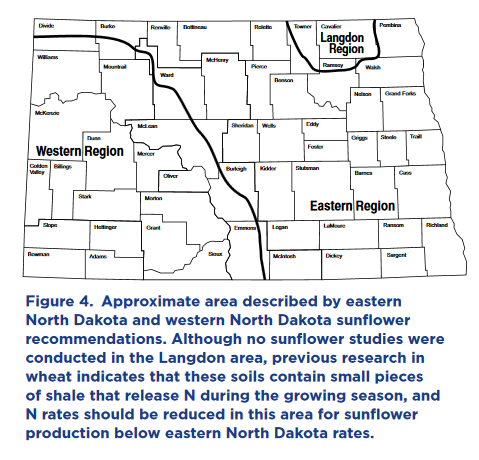
Eastern no-till sunflower N responses are similar to those of conventional till (Figures 5 and 6), although the N required to reach maximum yield is less. Both no-till and conventional till yield responses are quadratic, which means that after reaching maximum yield, yields decline with added N. Commercially, this decline could be due to lodging or increased susceptibility to disease. The yields behind these recommendations were determined on hand-harvested plots, and heads of all lodged plants were recovered. Western no-till sunflower response is different than those in the east (Figure 7), with positive yield responses even at what is currently considered excessive N rates. However, N recommendations also consider the hazard of greater lodging and perhaps greater disease severity with high N rates.
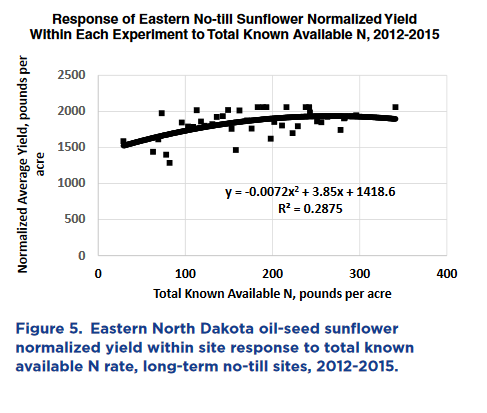
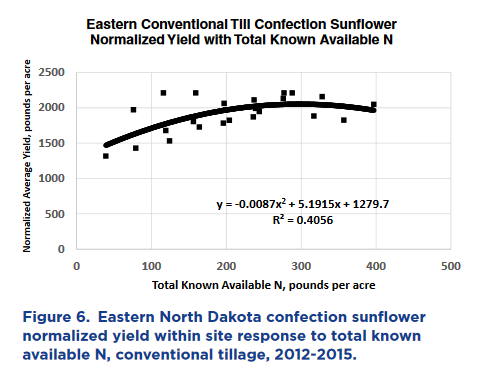
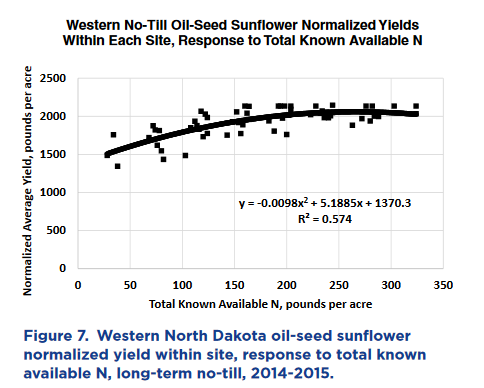
In a commercial field, some harvest loss is likely with lodging, so the upper limits of N rate were reduced in the recommendation tables to limit lodging loss. Although generally white mold and downy mildew seemed to be related to N rate, only one site was rated officially near the end of the study. This site, north of Dickinson, N.D., was rated for sunflower rust, which was caused by the fungus Puccinia helianthi, at harvest. The results of the rating are available in Table 1.
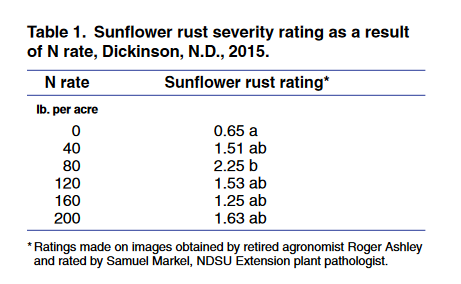
Excessive wind resulting in sunflower root lodging or stalk breakage does not happen in every sunflower field every year, but lodging is a concern of most sunflower growers. Several sites were affected by wind each year in our studies, and lodging severity was directly related to N rate (Figure 7 and Figure 8).
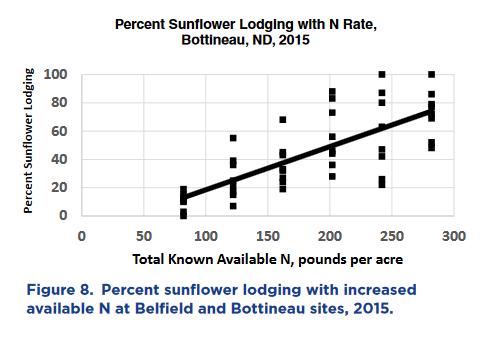
Although in our N rate experiments all heads were included in yield, sunflower growers would suffer a decrease in harvest efficiency when sunflowers are on or near the ground. Therefore, the N rate is capped in the no-till N recommendations, even though small increases in yield and marginal profit might be possible with greater N rates in nonwind-affected growing seasons.
Seed oil content of oil-seed sunflowers always decreased with N rate, regardless of yield response. The economic impact of available N on yield response, seed oil response and N cost is factored into each N recommendation. Highest N rates are moderated due to possible harvestable yield reduction due to lodging. The N rate recommendations are available in Tables 2-4.



The database that was accumulated to produce these recommendations did not include any conventional tillage site in the western region. Best recommendations for conventional tillage likely would be N rates similar to the no-till rates, but growers would need to expect lower yield, compared with their no-till neighbors in drier seasons.
The Langdon region was not represented in our database, but previous N rate experiments with wheat indicated about a 50-pound-per-acre N contribution from the slow-release mineralizable N within the shale pieces abundant in soils of this region. Therefore, the N calculator will subtract 50 pounds if the Langdon region is indicated from N rates of eastern conventional tillage in Table 3 or no-tillage in Table 4 until the 100 pound rate is achieved, then the rate from either table will be used.
Phosphorus
High soil phosphorus (P) levels and high rates of P fertilizer have not been found necessary for high sunflower yields in U.S. studies. Fallow does not appear to induce P deficiency in sunflower as it does in corn, despite the high reliance of sunflower on mycorrhiza.
Forty site-years of N and P rate experiments were conducted in western Nebraska during 1993 and 1994. Researchers found no effect of P rate on sunflower yield at any location. Most of the Nebraska sites had medium to high soil P levels, but some sites were classified in the low soil P range and yet did not respond to P (Geleta et al., 1997).
Of the 48 P rate experiments in North Dakota and South Dakota, only three had statistically greater yield, with P rates from 60 to 90 pounds of P2O5 per acre, compared with the check. At only one site was the yield increase economically beneficial when the cost of the P fertilizer was considered.
The recommendation for P fertilizer for sunflower in this region therefore is zero. Although the application of P fertilizer can be made and does not decrease yield, neither does it economically increase yield. Soil test P was not related to P response. Sunflower P removal in grain is very low, with only about 10 pounds of P2O5 per acre removed with a 2,000-pound-per-acre seed yield.
Potassium
Potassium (K) has been studied little in the region for sunflower. Around the world, K rate studies indicate that about 150 parts per million (ppm) from the standard K test in the region is sufficient for maximum sunflower yield.
South Dakota data from corn K rate studies indicate that if soil K levels are below 150 ppm, about 100 pounds per acre of 0-0-60 is necessary to maximize yields in any year. Therefore, if the soil test is below 150 ppm, the K fertilizer rate is a flat 100 pounds per acre rate of 0-0-60, or 60 pound per acre of K2O.
Sulfur
Sulfur (S) has become a common nutrient that is deficient for many crops in North Dakota. Although sunflower is deeply rooted, and in many soils, the groundwater is high in sulfates, sunflower may be susceptible to early season deficiency. The S soil test is not diagnostic.
A better prediction for possible S deficiency would be noting fall rainfall, winter snowfall, spring snowmelt and rainfall before planting. If any high precipitation is experienced, the possibility of S deficiency is greater.
Loam and coarser-textured soils are most susceptible to S deficiency. If S is anticipated to be deficient, an application of 10 pounds of S as a sulfate or thiosulfate source is recommended as preplant or postemergence before the reproductive stage (R1) of growth.
Elemental S application is not recommended. Do not apply any thiosulfate fertilizer with the seed. Also, sulfur is a spring fertilizer, so fall application is not recommended due to the likelihood of leaching in the spring before planting.
Other Nutrients
Of all the micronutrients, sunflower is most susceptible to boron (B) deficiency from reports around the world. However, in North Dakota, B rate experiments with soil B levels as low as 0.2 ppm showed no sunflower yield response with B application. Thus, no micronutrient application, including B application, is needed in North Dakota.
Organic Sunflower Nutrient Management
With the current market for organic foods of all kinds, sunflower lends itself well to certified organic production. For the requirements in North Dakota, contact the North Dakota Organic Advisory Board (www.ndorganics.nd.gov) for a list of U.S. Department of Agriculture-vetted certifiers.
Organic systems usually are depleted of N, but soil sampling can be helpful in determining the need for supplemental N amendments. One strategy organic growers use is to grow an early maturing crop, such as barley or winter wheat, the year before sunflowers and grow a cover crop of a fast-growing annual legume directly after grain harvest.
Compost also can be used to great advantage. The compost should come from a reliable source, where the manure was brought to temperatures that kill weed seed. Well-made composts can be sampled and analyzed for N content so that a better estimate can be made of N release during the sunflower growing year. A guide to producing and managing compost is available at www.ag.ndsu.edu/manure/documents/nm1478.pdf.
Compost also will contain substantial potassium, which might be limiting on very sandy soils, as well as sulfur. Sulfur fertilizers that also can be used include gypsum from natural sources and potassium sulfate (check with the North Dakota Organic Advisory Board for details).
Sunflower is susceptible to lodging and greater susceptibility to disease when too much N is applied, so rates of estimated available N should be conservative and should not exceed 150 pounds of N per acre. No micronutrient considerations are necessary for organic sunflower production in North Dakota.
References
Blackman, B.B., M. Scascitelli, N.C. Kane, H.H. Luton, D.A. Rasmussen, R.A. Bye, D.L. Lentz and L.H. Rieseberg. 2011.
Sunflower domestication alleles support single domestication center in eastern North America. Proc. Natl. Acad. Sci. USA 108:14360–14365.
Darby, H., E. Cummings, R. Madden and S. Monahan. 2013. 2012
Sunflower population and nitrogen rate trial. Univ. of Vermont Ext. Publ. Burlington, Vt.
Scheiner, J.D., F.H. Gutierrez-Boem and R.S. Lavado. 2002.
Sunflower nitrogen requirement and 15N fertilizer recovery in Western Pampas, Argentina. Eur. J. Agron. 17:73–79.
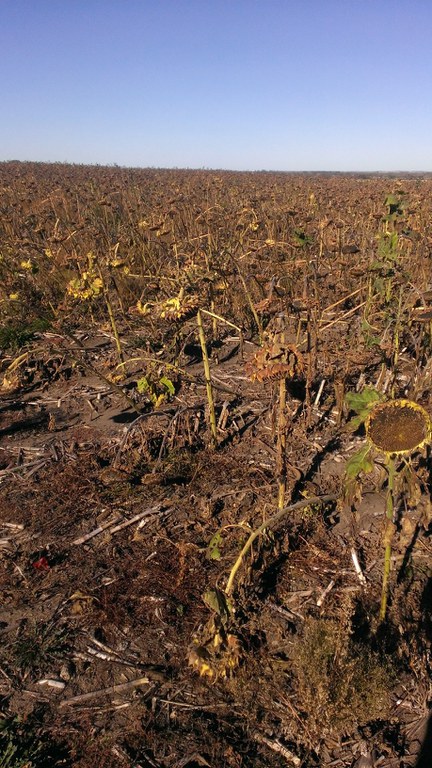
Sunflowers near harvest with significant lodging due to strong winds in a July thunderstorm.
(NDSU photo)
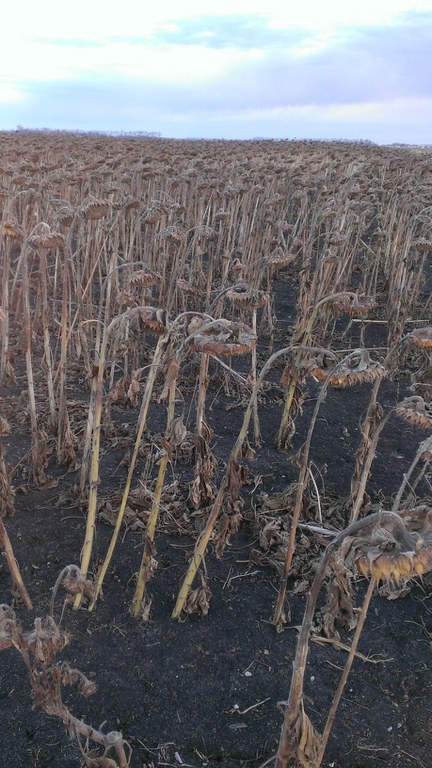
Sunflowers ready to harvest near Bottineau, N.D., 2015.
(NDSU photo)
The original publication was authored by W.C. Dahnke, C. Fanning and A. Cattanach, former NDSU researchers and Extension specialists, 1992.
The National Sunflower Association provided funding for the research that led to this revised publication.
The NDSU Extension Service does not endorse commercial products or companies even though reference may be made to trade names, trademarks or service names.
February 2016

